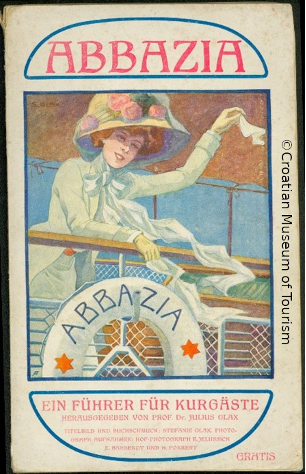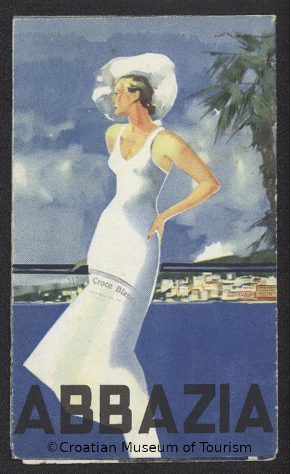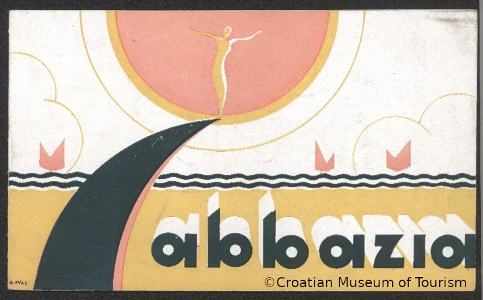Virtual Exhibit No 7: Promotional Brochures from Opatija at the Croatian Museum of Tourism (HR)
Tourist guide (front cover), Julius Glax, Stephanie Glax (illustrations), early 20th cent., HMT-1774
Image Credit: Croatian Museum of Tourism
Tourist guide (back cover), Julius Glax, Stephanie Glax (illustrations), early 20th cent., HMT-1774
Image Credit: Croatian Museum of Tourism
Brochure „Abbazia“ (front cover), between 1918 and 1943., Auskünfte Kurkommission Abbazia, HMT-2480
Image Credit: Croatian Museum of Tourism
Brochure „Abbazia“ (back cover), between 1918 and 1943., Auskünfte Kurkommission Abbazia, HMT-2480
Image Credit: Croatian Museum of Tourism
Brochure „Abbazia“ (front cover), 1940s, Grafitalia già Pizzi & Pizio, N.50 – Anno XVIII, HMT-2318
Image Credit: Croatian Museum of Tourism
Brochure „Abbazia“ (back cover), 1940s, Grafitalia già Pizzi & Pizio, N.50 – Anno XVIII, HMT-2318
Image Credit: Croatian Museum of Tourism
Brochure „Abbazia“ (front cover), 1930s, Comitato Provinciale del Turismo – Ufficio Propaganda, HMT-3360
Image Credit: Croatian Museum of Tourism
Brochure „Abbazia“ (back cover), 1930s, Comitato Provinciale del Turismo – Ufficio Propaganda, HMT-3360
Image Credit: Croatian Museum of Tourism
Opatija was formed as an elite resort destination from the mid-19th century. The company that capitalized on the benefits of the Opatija climate and position was the Austrian Southern Railway Company, with the building of the oldest hotel on the eastern Adriatic coast in 1884 – Hotel Quarnero (Kvarner). Until 1914 more than 30 hotels and hostelleries were erected, and some of them still exist and serve their original purpose. Opatija (Abbazia) was presented as a paradise on earth – an ideal holiday and health resort. It was promoted in many ways, in particular with postcards, brochures, and guides.
The person who was perhaps most instrumental in representing and developing Opatija as a health and bathing district was Julius Glax, a doctor in Opatija, chief physician of the Southern Railway Sanatorium, and the Austrian Red Cross. As the director of Opatija's Health Centre between 1899 and 1919, he supervised and managed the development of the infrastructure necessary for the resort's success.
He was also famous for his Opatija tourist-guides. His daughter, Stephanie Glax, was a painter and graphic designer, and designed her father's guides in Czech, French, German, and Croatian. The guides presented here are part of the collection of printed materials of the Croatian Museum of Tourism.
The folded brochure named „Abbazia“ – the front cover of which shows a couple in a yellow gown and black tailcoat enjoying the evening view on the Quarnero, and on the back a lady in a white gown and a hat relishing the prospect across the water – was printed between 1918 and 1943 by Auskünfte Kurkommission Abbazia. The text is written in German and contains information about Opatija, its climate, accommodation, health facilities, trips, and a map. Pieces of information are always followed by photographs of Opatija and its touristic higlights. The back cover illustration has a stamp „Hotel Croce Bianca“.
The next brochure named „Abbazia“ – the front cover of which shows a sailing scene and the back cover a couple of tennis players gazing at the sea – was produced in the 1940s. The brochure was printed by Grafitalia già Pizzi & Pizio in Milan and authorized by the Ministero Cultura Populare – Dir. Gen. Turismo (Direzione Generale del Turismo). It is written in Croatian and contains advertising for Opatija (Abbazia) with photographs, illustrations, and photomontages, showing beaches, landscapes and architecture. The name of the artist: „Lenna...“ is written on the back.
The following brochure of this display, again named „Abbazia“, has on its front cover a depiction of a girl who stands on a shape that evokes a diving tower. She has her arms opened to, and her gaze on the sun and sea with sails on the horizon. Its back cover shows a photography of group of people seated at the public park „Angiolina“ in Opatija. Created in the 1930s, the brochure was published by Comitato Provinciale del Turismo – Ufficio Propaganda. The front cover illustration is signed with „Gavas“. The brochure contains tourist information in Italian, accompanied by photographs of Opatija and surroundings that were taken by Mayer from Opatija.
The last brochure „Opatija Yugoslavia“ shows on its front cover a depiction of the town as seen from the Adriatic coast, and on its back an illustration of a ship from Yugoslavia, sailing under the flags of Europe. The images were created in 1955 by Edo Murtić, a famous Croatian artist, and published by the art direction of LIKUM (Zadruga likovnih umjetnika Hrvatske / Association of Croatian Artists). The photos inside the brochure, provided by the Graphic Institute of Croatia (Grafički zavod Hrvatske) were taken by Dabac, Zuber and Gersy. Its text – provided in English and Spanish – describes Opatija as the noblest pearl of the Kvarner riviera. [...] Here the scent of the sea mingles with the sweet smell of lemons, camellias, orchids, myrhtes, marjoram, and tamarisk in the quiet of the parks. The brochure invites tourists to enjoy Opatija and its nature, culture, and people.
Curator: Mirjana Kos Nalis








